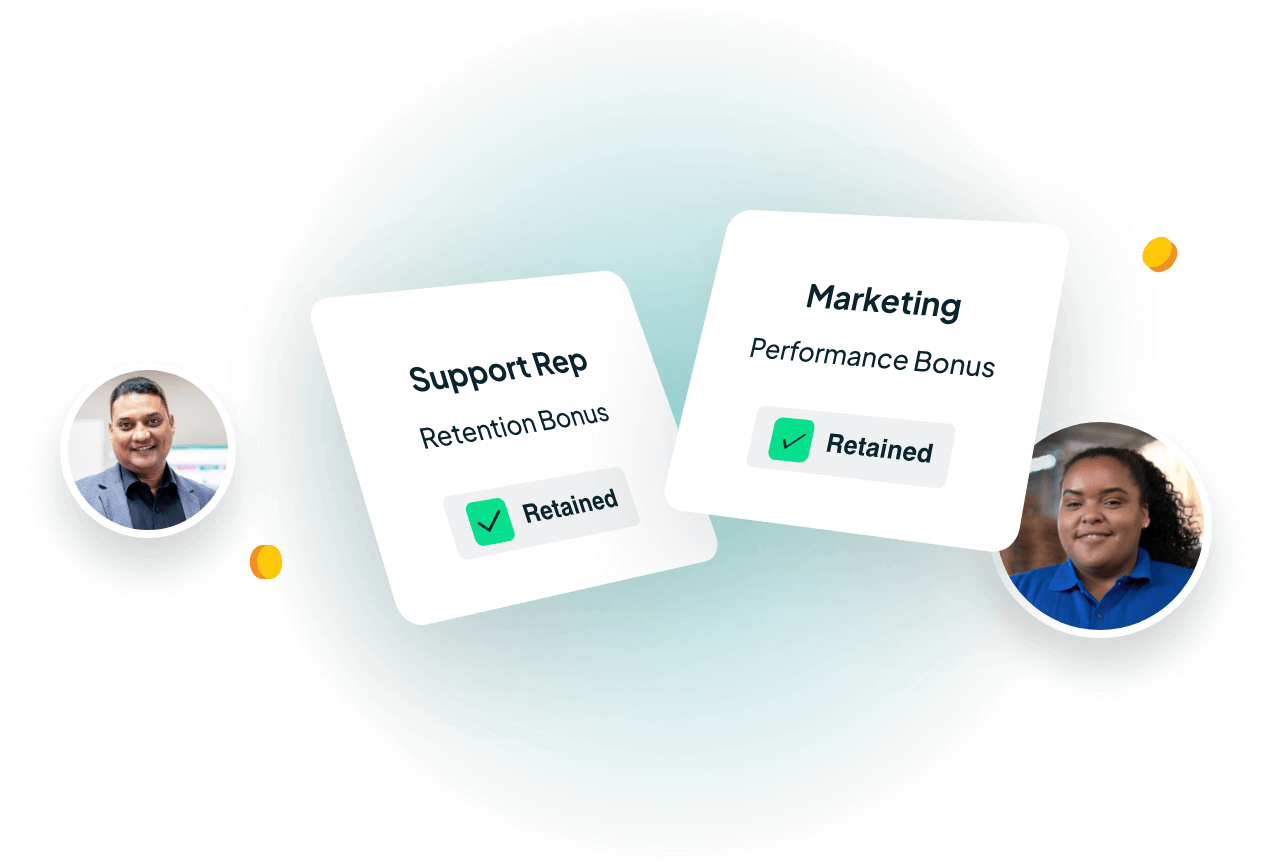-
Why Keep?
Why Keep
-
Employers
-
Employees
-
- Solutions
- Resources
- About Us
The Ultimate Guide to Employee Retention & Strategies
Table of Contents
- The Ultimate Guide to Employee Retention (2023)
- What is Employee Retention?
- What is Employee Retention vs Employee Engagement?
- Why is Employee Retention Important?
- Develop Strategies to Help Retain Talent
- Utilize Employee Retention Tools & Resources
- Create an Inclusive Workplace - How You Can Make Employees Feel Valued and Appreciated
- Understand Your Employees' Needs - What Are Your Employees Looking For From Their Job
- Develop a Training Program - What Training Opportunities Will Help Your Team Learn & Grow
- Measure Performance - How to Track Progress & Reward Achievements
- Comprehensive Bonuses & Compensation - How to Empower Your Employees to be Financially Driven
- Keep Your Talent Retained - With Keep Financial
The Ultimate Guide to Employee Retention
Attracting great employees and keeping them on board are two of the biggest challenges that organizations face in today’s competitive landscape. That's why it is essential to have an effective employee retention strategy in place–one that allows you to keep your best workers engaged, motivated, and committed to achieving long-term success.
As a Finance leader, understanding the core elements of an employee retention strategy can help you create a financially stable environment where your people not only stay with your company for longer but also perform at their highest potential. Employee retention drives down costs in the long-term by reducing turnover expenses, recruitment costs, and training expenses. To ensure the success of your company's employee retention efforts, we have created The Ultimate Guide to Employee Retention - an all-encompassing resource that provides actionable tips and tactics designed to jumpstart successful employee retention initiatives.
Whether you're just starting out or already have some methods up your sleeve, this comprehensive guide will provide invaluable insights into best practices for effective employee retention within any organization.
What is Employee Retention?
Employee retention is a vital aspect of a thriving business environment, as it refers to the organization's ability to maintain and nurture a stable, dedicated, and skilled workforce. This process involves creating a positive work atmosphere that encourages employees to stay with the company for the long term, thus preventing the loss of valuable talent and the associated costs of high employee turnover.
To achieve high employee retention rates, companies often focus on offering competitive compensation, fostering professional and personal growth, providing employees with a sense of purpose, and cultivating a sense of camaraderie among staff members. By valuing their employees and implementing effective retention strategies, organizations can ensure that they maintain a solid workforce and continue to thrive in a competitive business landscape.
What is Employee Retention vs Employee Engagement?
Employee retention refers to an organization's ability to retain its employees for a significant period of time. It is a measure of the extent to which employees stay with an organization, rather than leaving to work elsewhere.
Employee retention is important because high levels of turnover can be costly for organizations, both in terms of recruitment and training costs, and the potential loss of institutional knowledge and skills.
Employee engagement, on the other hand, refers to the extent to which employees are invested in their work and committed to the goals of the organization. Engaged employees are those who feel a sense of ownership over their work and are motivated to perform to the best of their abilities.
Engaged employees tend to be more productive and are less likely to leave an organization.
While retention and engagement are related, they are not the same thing. An organization can have high retention rates but low engagement levels if employees are staying because they feel they have no other options. Similarly, an organization can have top talent but struggle with retention if the company does not offer competitive compensation or opportunities for advancement.
In summary, employee retention refers to an organization's ability to keep its employees, while employee engagement refers to the level of commitment and investment that employees have in their work and the organization. Both are important for the success of an organization and require different strategies to achieve.
Why is Employee Retention Important?
Employee retention is of vital importance when it comes to the success and growth of a business or organization. The ability to keep and maintain an experienced and motivated workforce not only reduces costs associated with frequent employee turnover but also provides a strong foundation for a nurturing and positive work culture.
High retention rates often signify that employees are satisfied and feel valued, leading to increased productivity and performance. Loyal and long-standing employees tend to have a deeper understanding of the company's visions and goals, which ultimately supports more efficient decision-making and problem-solving.
With the competitive nature of today's job market, focusing on employee retention strategies has become a pivotal factor in ensuring the sustainability and overall prosperity of a business.
Develop Employee Retention Strategies to Help Retain Talent
In today's fast-moving and competitive world, retaining top talent is more important than ever to ensure the success of an organization. Having the best-skilled personnel on board not only adds value to the company but also fosters growth while avoiding the high cost of talent replacement.
Therefore, it is crucial to develop proactive strategies that create a conducive environment for employees to thrive and excel within the organization. These strategies may include providing ongoing training and development, offering competitive compensation packages, and maintaining open lines of communication for employee feedback.
Implementing them not only boosts employee morale but also builds a strong sense of loyalty towards the company, thus encouraging talented individuals to stay and grow with the organization for the long haul.
Many factors contribute to employee retention, but here are five main strategies that are widely recognized as being crucial:
- Company culture: The culture of an organization plays a significant role in employee retention. Employees who feel that their values align with the company's culture are more likely to stay long-term.
- Opportunities for growth and development: Employees who have access to professional development opportunities and the chance to advance their careers within the organization are more likely to remain with the company.
- Work-life balance: An organization that prioritizes work-life balance and offers flexible scheduling, generous vacation time, and other benefits that support employees' personal lives will have a more engaged and satisfied workforce.
- Good management: Employees who have supportive and effective managers are more likely to stay with an organization. Managers who provide regular feedback, recognize and reward employee achievements, and foster positive working relationships can help create a strong sense of loyalty and commitment among their team members.
- Compensation and benefits: Competitive compensation and benefits packages are key factors in attracting and retaining talent. Employees need to feel that they are being compensated fairly for their work.
It's worth noting that these drivers are not mutually exclusive, and they can interact with each other in complex ways. For example, a positive company culture can help create opportunities for growth and development, while a supportive manager can contribute to work-life balance.
Utilize Employee Retention Tools & Resources
In today's competitive business environment, retaining valuable employees has become increasingly important for organizations to succeed and prosper. Utilizing a variety of employee retention tools and resources is essential in keeping employees motivated, engaged, and committed to their work.
By investing resources in employee development programs, mentorship opportunities, and a responsive feedback system, companies can foster a positive work environment and strengthen their working relationships. Offering competitive compensation and benefits packages, coupled with flexible work arrangements, also communicates a strong commitment by the organization to value and respect employee contributions.
Collaborative team-building activities can help foster personal connections among team members, enhancing employee satisfaction and overall work experience. By utilizing a holistic approach to employee retention, organizations can secure greater long-term success and maintain a thriving workforce that drives continual growth and innovation.
Create an Inclusive Workplace - How To Make Employees Feel Valued and Appreciated
Creating an inclusive workplace is vital to ensuring that employees feel valued and appreciated, fostering a positive work environment where everyone's contributions are recognized. One way to achieve this goal is by actively promoting diversity and inclusion initiatives, which can help break down barriers and encourage open dialogue among staff members.
Encourage employees to share their ideas and offer constructive feedback, as this fosters a collaborative environment and allows everyone to feel heard. Additionally, consider offering training and support for managers to enable them to create an inclusive culture within their teams.
Celebrate the accomplishments and successes of all employees by acknowledging individual and group achievements, and embrace a transparent communication style throughout the organization, so that everyone feels respected and appreciated. Implementing these strategies can help create an inclusive workplace where employees feel valued, leading to increased job satisfaction, productivity, and overall success.
Understand Your Employees' Needs - What Are Your Employees Looking For From Their Job
In today's competitive job market, employers need to recognize and understand their employees' needs to attract and retain top talent. Meeting diverse individual needs goes beyond offering competitive salaries and benefits packages.
As an employer, you should consider the various factors that contribute to job satisfaction, such as work-life balance, professional development opportunities, and a supportive work environment. By fostering a culture of open communication and feedback, you can better understand your employees' personal and professional aspirations, as well as their unique concerns and challenges.
Investing time and resources to address these diverse needs not only results in increased employee satisfaction and loyalty but also leads to a more productive and successful workforce. Remember, when your employees feel valued and supported, they are more likely to go the extra mile and contribute to the overall success of your organization.
Develop a Training Program - What Training Opportunities Will Help Your Team Learn & Grow
Developing a comprehensive and efficient training program is crucial to ensuring your team reaches its full potential, continually learns, and grows professionally. A well-rounded program incorporates various training opportunities that address your team's unique needs, interests, and skill sets.
By combining in-person workshops, online classes, and hands-on experiences like job shadowing, you create an engaging and collaborative learning environment that empowers employees to develop valuable new skills. Incorporating mentorship programs and regular performance evaluations ensures that feedback is continuously given and goals are set for further improvement.
In the ever-changing world of business, investing in your team's professional development not only gives you a competitive edge but also fosters a sense of loyalty, satisfaction, and camaraderie among the team members.
Measure Performance - How to Track Progress & Reward Achievements
Measuring performance, tracking progress, and rewarding achievements are integral components for growth and success, whether in personal endeavors, career goals, or business strategies.
Accurate performance evaluation helps identify strengths and weaknesses, while continuous progress tracking enables target adaptability as we strive for improvement. Establishing a reward system complements this process by fostering motivation and boosting morale, recognizing the hard work and dedication behind every accomplishment.
By incorporating these elements together, a culture of learning, excellence, and positive reinforcement is nurtured, driving individuals and organizations toward reaching their full potential, and ultimately paving the path to continuous success.
Comprehensive Bonuses & Compensation - How to Empower Your Employees to be Financially Driven
A comprehensive bonus and compensation system is a powerful mechanism to inspire and empower your employees to be financially driven. By offering monetary incentives that directly align with the achievement of company goals and your employee's life goals, you establish an enticing motivation for people to take ownership of their roles and excel in their performance.
It is essential for these rewards to be competitive in your industry, and tailored to individual needs and desires - this not only fosters a fair working environment but also boosts employee satisfaction and retention rates. Moreover, incorporating consistent feedback, peer recognition, and timely payouts demonstrates a company's unwavering commitment to acknowledging hard work and success. In turn, this encourages a passionate and motivated workforce, pushing its limits and thriving collectively toward long-term, sustainable business growth.
Keep Financial's vesting cash bonus is a powerful tool that can help organizations increase employee retention. By offering employees an upfront cash bonus that vests over a set period, companies can incentivize their employees to stay with the organization and work towards long-term goals. This type of bonus can be particularly effective for key employees or those in specialized roles where retention is critical to the organization's success.
Keep Your Talent Retained - With Keep Financial
Employee retention is an important part of any successful operation. Developing strategies, utilizing resources, and creating an inclusive workplace are all essential steps to having strong employee retention. By understanding employee needs, training them with opportunities they can learn and grow from, measuring performance and rewarding achievements, and comprehensive bonuses & compensations, you can empower your employees to be driven by both their work and financial goals.
Building a foundation of trust and loyalty among your employees is key to successful employee retention - the two go hand in hand. As we come to the end of our article on everything you need to know about Employee Retention & Strategies, here’s hoping it has given you a better understanding of how best to retain talent within your organization.
We hope that this ultimate guide will assist you in crafting the perfect employee retention plan for your teams. If you have any questions, schedule a demo with Keep today!
Get more insight.




